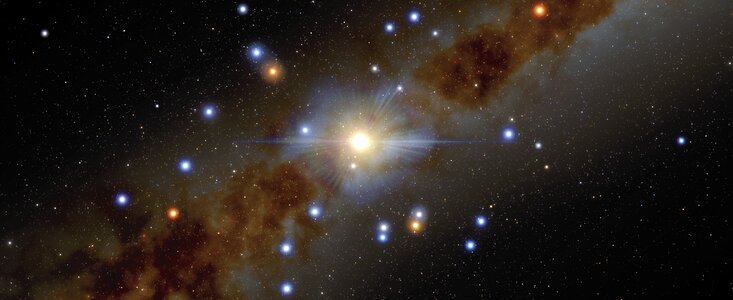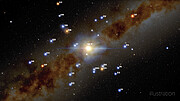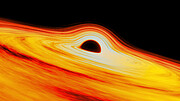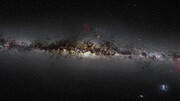Precise Insights into the Supermassive Black Hole in the Milky Way’s Heart
Astronomers use Gemini Observatory and an international telescope collaboration to shed light on Sagittarius A*
14 December 2021
Astronomers have made the most precise measurements yet of the motions of stars around the supermassive black hole at the center of the Milky Way. These results, obtained with the help of the Gemini North telescope, show that 99.9% of the mass contained at the very center of the galaxy is due to the black hole, and only 0.1% could include stars, smaller black holes, interstellar dust and gas, or dark matter.
Astronomers have measured more precisely than ever before the position and velocity of four stars in the immediate vicinity of the supermassive black hole that lurks at the center of the Milky Way, known as Sagittarius A* (Sgr A*) [1]. These stars — called S2, S29, S38, and S55 — were found to be moving in a way that shows that the mass in the center of the Milky Way is almost entirely due to the Sgr A* black hole, leaving very little room for anything else.
The team used a variety of cutting-edge astronomical facilities in this research. To measure the velocities of the stars, they used spectroscopy from the Gemini Near Infrared Spectrograph (GNIRS) at Gemini North near the summit of Maunakea in Hawai‘i, part of the international Gemini Observatory, a program of NSF’s NOIRLab, and the SINFONI instrument on the European Southern Observatory’s Very Large Telescope. The positions of the stars were measured with the GRAVITY instrument at the VLTI. [2]
“We are very grateful to Gemini Observatory, whose GNIRS instrument gave us the critical information we needed,” said Reinhard Genzel, director of the Max Planck Institute for Extraterrestrial Physics and co-recipient of the 2020 Nobel Prize in physics. “This research shows world-wide collaboration at its best.”
The Galactic Center of the Milky Way, located roughly 27,000 light-years from the Sun, contains the compact radio source Sgr A* that astronomers have identified as a supermassive black hole 4.3 million times as massive as the Sun. Despite decades of painstaking observations — and the Nobel Prize awarded for discovering the identity of Sgr A* [3] — it has been difficult to conclusively prove that the majority of this mass belongs only to the supermassive black hole and does not also include a vast amount of matter such as stars, smaller black holes, interstellar dust and gas, or dark matter.
“With the 2020 Nobel prize in physics awarded for the confirmation that Sgr A* is indeed a black hole, we now want to go further. We would like to understand whether there is anything else hidden at the center of the Milky Way, and whether general relativity is indeed the correct theory of gravity in this extreme laboratory,” explained Stefan Gillessen, one of the astronomers involved in this work. “The most straightforward way to answer that question is to closely follow the orbits of stars passing close to Sgr A*.”
Einstein’s general theory of relativity predicts that the orbits of stars around a supermassive compact object are subtly different from those predicted by classical Newtonian physics. In particular, general relativity predicts that the orbits of the stars will trace out an elegant rosette shape — an effect known as Schwarzschild precession. To actually see stars tracing out this rosette, the team tracked the position and velocity of four stars in the immediate vicinity of Sgr A* — called S2, S29, S38, and S55. The team’s observations of the extent to which these stars precessed allowed them to infer the distribution of mass within Sgr A*. They discovered that any extended mass within the orbit of the S2 star contributes at most the equivalent of 0.1% of the mass of the supermassive black hole.
Measuring the minute variations in the orbits of distant stars around our galaxy's supermassive black hole is incredibly challenging. To make further discoveries, astronomers will have to push the boundaries not only of science but also of engineering. Upcoming extremely large telescopes (ELTs) such as the Giant Magellan Telescope and the Thirty Meter Telescope (both part of the US-ELT Program) will allow astronomers to measure even fainter stars with even greater precision.
“We will improve our sensitivity even further in future, allowing us to track even fainter objects,” concluded Gillessen. “We hope to detect more than we see now, giving us a unique and unambiguous way to measure the rotation of the black hole.”
“The Gemini observatories continue to deliver new insight into the nature of our galaxy and the enormous black hole at its center,” said Martin Still, Gemini Program Officer at the National Science Foundation. “Further instrument development during the next decade intended for broad use will maintain NOIRLab’s leadership in the characterization of the Universe around us.”
Notes
[1] Sagittarius A* is spoken as “Sagittarius A star.”
[2] ESO’s VLT is composed of four individual colocated 8.2-meter telescopes which can combine light through a network of mirrors and underground tunnels using a technique known as interferometry, to form the VLTI. GRAVITY uses this technique to measure the position of night-sky objects with high accuracy — equivalent to picking out a quarter-dollar coin on the surface of the Moon.
[3] The 2020 Nobel Prize in Physics was awarded in part to Reinhard Genzel and Andrea Ghez "for the discovery of a supermassive compact object at the centre of our galaxy".
More information
This research is presented in the paper “The mass distribution in the Galactic Centre from interferometric astrometry of multiple stellar orbits” to appear in Astronomy & Astrophysics. A companion paper "Deep Images of the Galactic Center with GRAVITY" will also appear in Astronomy & Astrophysics.
The team behind this result is composed of The GRAVITY Collaboration, R. Abuter (European Southern Observatory), A. Amorim (Universidade de Lisboa and CENTRA - Centro de Astrofísica e Gravitação), M. Bauböck (Max Planck Institute for Extraterrestrial Physics and University of Illinois), J. P. Berger (University Grenoble Alpes and European Southern Observatory), H. Bonnet (European Southern Observatory), G. Bourdarot (University Grenoble Alpes and Max Planck Institute for Extraterrestrial Physics), V. Cardoso (CENTRA - Centro de Astrofísica e Gravitação and CERN), Y. Clénet (LESIA, Observatoire de Paris), Y. Dallilar (Max Planck Institute for Extraterrestrial Physics), R. Davies (Max Planck Institute for Extraterrestrial Physics), P. T. de Zeeuw (Leiden University and Max Planck Institute for Extraterrestrial Physics), J. Dexter (University of Colorado, Boulder), A. Drescher (Max Planck Institute for Extraterrestrial Physics), A. Eckart (University of Cologne and Max Planck Institute for Radio Astronomy), F. Eisenhauer (Max Planck Institute for Extraterrestrial Physics), N. M. Förster Schreiber (Max Planck Institute for Extraterrestrial Physics), P. Garcia (Universidade do Porto and CENTRA - Centro de Astrofísica e Gravitação), F. Gao (Universität Hamburg and Max Planck Institute for Extraterrestrial Physics), E. Gendron (LESIA, Observatoire de Paris), R. Genzel (Max Planck Institute for Extraterrestrial Physics and University of California, Berkeley), S. Gillessen (Max Planck Institute for Extraterrestrial Physics), M. Habibi (Max Planck Institute for Extraterrestrial Physics), X. Haubois (European Southern Observatory), G. Heißel (LESIA, Observatoire de Paris), T. Henning (Max Planck Institute for Astronomy), S. Hippler (Max Planck Institute for Astronomy), M. Horrobin (University of Cologne), L. Jochum (European Southern Observatory), L. Jocou (University Grenoble Alpes), A. Kaufer (European Southern Observatory), P. Kervella (LESIA, Observatoire de Paris), S. Lacour (LESIA, Observatoire de Paris), V. Lapeyrère (LESIA, Observatoire de Paris), J.-B. Le Bouquin (University Grenoble Alpes), P. Léna (LESIA, Observatoire de Paris), D. Lutz (Max Planck Institute for Extraterrestrial Physics), T. Ott (Max Planck Institute for Extraterrestrial Physics), T. Paumard (LESIA, Observatoire de Paris), K. Perraut (University Grenoble Alpes), G. Perrin (LESIA, Observatoire de Paris), O. Pfuhl (European Southern Observatory and Max Planck Institute for Extraterrestrial Physics), S. Rabien (Max Planck Institute for Extraterrestrial Physics), G. Rodríguez-Coira (LESIA, Observatoire de Paris), J. Shangguan (Max Planck Institute for Extraterrestrial Physics), T. Shimizu (Max Planck Institute for Extraterrestrial Physics), S. Scheithauer (Max Planck Institute for Astronomy), J. Stadler (Max Planck Institute for Extraterrestrial Physics), O. Straub (Max Planck Institute for Extraterrestrial Physics), C. Straubmeier (University of Cologne), E. Sturm (Max Planck Institute for Extraterrestrial Physics), L. J. Tacconi (Max Planck Institute for Extraterrestrial Physics), K. R. W. Tristram (European Southern Observatory), F. Vincent (LESIA, Observatoire de Paris), S. von Fellenberg (Max Planck Institute for Extraterrestrial Physics), F. Widmann (Max Planck Institute for Extraterrestrial Physics), E. Wieprecht (Max Planck Institute for Extraterrestrial Physics), E. Wiezorrek (Max Planck Institute for Extraterrestrial Physics), J. Woillez (European Southern Observatory), S. Yazici (Max Planck Institute for Extraterrestrial Physics and University of Cologne), and A. Young (Max Planck Institute for Extraterrestrial Physics).
NSF’s NOIRLab (National Optical-Infrared Astronomy Research Laboratory), the US center for ground-based optical-infrared astronomy, operates the international Gemini Observatory (a facility of NSF, NRC–Canada, ANID–Chile, MCTIC–Brazil, MINCyT–Argentina, and KASI–Republic of Korea), Kitt Peak National Observatory (KPNO), Cerro Tololo Inter-American Observatory (CTIO), the Community Science and Data Center (CSDC), and Vera C. Rubin Observatory (operated in cooperation with the Department of Energy’s SLAC National Accelerator Laboratory). It is managed by the Association of Universities for Research in Astronomy (AURA) under a cooperative agreement with NSF and is headquartered in Tucson, Arizona. The astronomical community is honored to have the opportunity to conduct astronomical research on Iolkam Du’ag (Kitt Peak) in Arizona, on Maunakea in Hawai‘i, and on Cerro Tololo and Cerro Pachón in Chile. We recognize and acknowledge the very significant cultural role and reverence that these sites have to the Tohono O'odham Nation, to the Native Hawaiian community, and to the local communities in Chile, respectively.
Links
Contacts
Stefan Gillessen
Max Planck Institute for Extraterrestrial Physics
Tel: +49 89 30000 3839
Email: ste@mpe.mpg.de
Amanda Kocz
Press and Internal Communications Officer
NSF’s NOIRLab
Tel: +1 520 318 8591
Email: amanda.kocz@noirlab.edu
About the Release
| Release No.: | noirlab2130 |
| Facility: | Gemini North |
| Instruments: | GNIRS |
| Science data: | 2022A&A...657L..12G 2022A&A...657A..82G |









